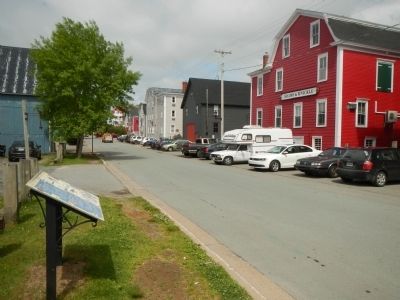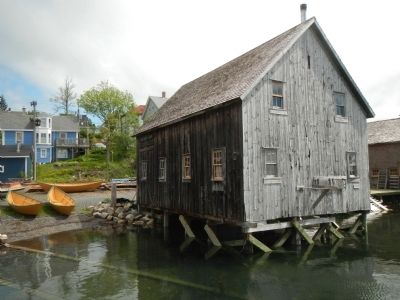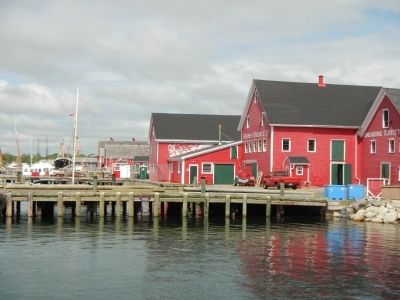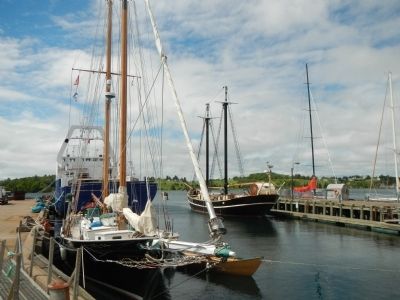Lunenburg in Lunenburg County, Nova Scotia — The Atlantic Provinces (North America)
Lunenburg’s Shipbuilding Tradition
La tradition de la construction navale à Lunenburg
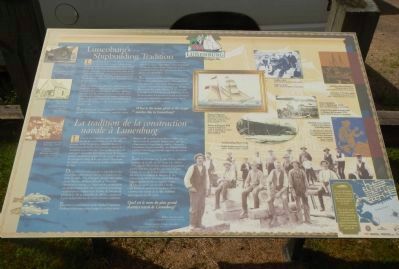
Photographed By Barry Swackhamer, June 16, 2014
1. Lunenburg’s Shipbuilding Tradition Marker
Captions (English / French): (left edge, top to bottom) E. Bally’s Blacksmith Shop, c. 1890 / Forge d’E. Bally, vers 1890; Thomas Walker’s Blacksmith Shop, c. 1900 . Forge de Thomas Walker, vers 1900; A. Dauphiner & Son Block Shop, c. 1910 / Fabrique de poulies A. Dauphiner & Son Block Shop, vers 1910; (right side, clockwise from the top) Caulkers on deck / Calfats sur le pont; Lunenburg schooner Marjorie & Dorothy, built in 1934 / Le Marjorie & Dorothy, goélette de Lunenburg construite en 1934; Schooner launching at Smith & Rhuland yard, 1920’s / Lancerment d’une goélette au chantier Smith & Rhuland dans les années 1920; Sailmaking was an important component of Lunenburg's shipbuilding industry. / La fabrication des voiles était une composante de l’industrie de la construction navale à Lunenburg.; Workers pause for a photo. / Ouvriers au repose le temps d’une photo.; Auxiliary fishing schooner on slip. / Goélette de pêche motorisé sur cale.; Painting of Brigantine Brill built at Broad Cove, Lunenburg County in 1857. / Peinture de Brigantine Brill construit à Broad Cove, comté de Lunenburg en 1857.
Lunenburg’s success in the fishery stimulated the construction of many fishing vessels. Almost all of the schooners fishing out of Lunenburg during the Town’s first 200 years were built in the Town or in other Lunenburg County ports. Local shipbuilders also built vessels which were involved in the carrying trade along the eastern seaboard of North America and south to the West Indies and South America.
Many builders specialized in smaller boats such as whalers, dories, skiffs and flats. Boatbuilders such as Joseph McLachlan, James Maxner, William Morash, and Alexander Anderson were just a few of the Town’s well-known boat builders. Lunenburg dories, used exclusively bt the Town’s fishing fleet for over 100 years, were the main product of the smaller yards.
Shipbuilding and boat building also led to the growth of industries required to outfit the vessels and the Town became the home of numerous sailmakers, riggers, shipwrights, marine blacksmiths and marine engine shops. Shipyards such as Lunenburg Foundry also refitted vessels during the Second World War.
The Town’s most renowned 20th century shipyard was Smith and Rhuland. From 1900 until 1975, more than 210 vessels, mostly fishing schooners and trawlers, were launched from her ways. Beside Bluenose and her replica Bluenose II, the yard also built the replicas of HMS Bounty and HMS Rose. Soctia Trawler Limited, the successor to Smith and Rhuland carries on a shipbuilding tradition in the Town dating back to the 18th century.
What is the name given to the major marine slip in Lunenburg?
French
Le succès des Lunenbourgeois dans la pêche stimule la construction navale. En effet, presque toutes les goélettes de pêche basées à Lunenburg durant les 200 premières années de sa foundation sont construites dans la ville ou dans un autre port du comté. Les constructeurs de bateaux locaux construisent également des navires qui font du transport le long de la côté est de l’Amérique du Nord et vers le Sud, dans les Antilles et l’Amérique du Sud.
De nombreux constructeurs se spécialisent dans les petites embarcations comme les baleiniers, les doris, les skiffs et les chaloupes. Joseph McLachlan, James Maxner, William Morash et Alexander Anderson ne sont que quelque-uns des constructeurs navales bien connus de la ville. Les doris de Lunenburg exclusivement employés par la flotte de bateaux de pêche de la ville pendant plus 100 ans, constituent le principal produit issu des petites chantiers maritimes.
En outre, la construction navale entraine l’expansion d’industries nécessures pour équiper les embarcations. Ainsi, la ville accueille de nombreux
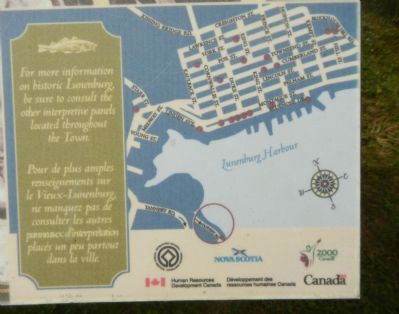
Photographed By Barry Swackhamer, June 16, 2014
2. Detail from the Marker
For more information on historic Lunenburg, be sure to consult the other interpretive panels located throughout the Town. / Pour de plus ample renseignements sur le Vieux-Lunenburg, ne manquez pas de consulter les autres panneaux d’interprétation placés un peu partout dans la ville.
Smith ad Rhuland est le plus célèbre chantier maritime de la ville au 20ᵉ siècle. De 1900 à 1975, plus de 270 navires, le plupart de goélettes et des chalutiers de pêche, sont mis à la mer à partir de sa cale de lancement. Outre le Bluenose et sa réplique le Bluenose II, des répliques du HMS Bounty et du HMS Rose sortent également de ce chantier. Scotia Trawler Limited, que succède à Smith and Rhuland, poursuit la tradition de la construction navale de la ville, tradition qui remonte au 18ᵉ siècle.
Quel est le nom du plus grand chantier naval de Lunenburg?
Erected by Town of Lunenburg.
Topics. This historical marker is listed in these topic lists: Industry & Commerce • Waterways & Vessels. A significant historical year for this entry is 1900.
Location. 44° 22.544′ N, 64° 18.461′ W. Marker is in Lunenburg, Nova Scotia, in Lunenburg County. Marker is on Bluenose Drive close to Hopson Street, on the right when traveling east. Touch for map. Marker is at or near this postal address: 170 Bluenose Drive, Lunenburg NS B0J, Canada. Touch for directions.
Other nearby markers. At least 8 other markers are within walking distance of this marker. Rum Running (about 120 meters away, measured in a direct line); “…for those in peril on the sea.” (about 180 meters away); Lunenburg - Home of the Bluenose & Bluenose II (about 210 meters away); The Labrador Whaler Anderson Bros. (approx. 0.2 kilometers away); Lunenburg’s Fishing Industry Since 1940’s (approx. 0.3 kilometers away); Lunenburg’s Fishing Industry 1870’s - 1940’s (approx. 0.3 kilometers away); Old Town Lunenburg Historic District (approx. 0.3 kilometers away); Foreign Protestants & the Settlement of Lunenburg (approx. 0.3 kilometers away). Touch for a list and map of all markers in Lunenburg.
Credits. This page was last revised on June 16, 2016. It was originally submitted on October 20, 2014, by Barry Swackhamer of Brentwood, California. This page has been viewed 671 times since then and 18 times this year. Photos: 1, 2, 3, 4, 5, 6. submitted on October 20, 2014, by Barry Swackhamer of Brentwood, California. • Andrew Ruppenstein was the editor who published this page.
